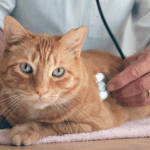Until the late 1980s, the feline leukemia virus was the only agent linked to acquired immunodeficiency syndrome in cats—that is, it was until the feline immunodeficiency virus (FIV) (also known as “feline AIDS”) was identified. This organism is unlike the feline leukemia virus in that it belongs to the same subfamily of retroviruses as the human AIDS virus (HIV). FIV is now known to be widespread among the cat population across the United States and around the world.
FIV behaves the same way in cats as HIV does in humans; that is, it attacks the host’s immune system and debilitates it, leaving the body wide open to secondary invaders and disease. The disease does not appear to be readily sexually transmitted in cats, and rarely is it passed on through casual contact with saliva, urine, or other body fluids, as the feline leukemia virus can be.
Instead, the main mode of transmission of FIV between cats is through penetrating bite wounds that introduce infected saliva deep into the tissues. This method of transmission is said to be analogous to the use of a dirty hypodermic needle in humans as a means of spreading HlV between people. Needless to say, non-neutered male cats between the ages of 3 and 10 years that are allowed to roam about the neighborhood and fight with other cats are at greatest risk of contracting this deadly disease.
Clinical signs associated with FIV in cats can be quite variable because of the immunosuppressive nature of the disease. Some cats might be carriers of the disease, not showing any clinical signs of illness whatsoever. In others, the only subtle signs noticed might be recurring infections (abscesses and skin infections, respiratory infections, bladder infections, etc.), weight loss, or chronic gingivitis and bad breath.
Chronic, unresponsive diarrhea is another sign commonly seen in cats harboring FIV. Lymph node enlargement, loss of appetite, cancerous growths, and/or bizarre behavioral changes might also be present in an active infection. Finally, FIV makes the affected cat more susceptible to parasitic infections, such as toxoplasmosis, hemobartonellosis, and demodecosis, and their associated clinical syndromes.
Diagnosis of FIV can be made in a veterinarian’s office using a quick, easy test similar to the one used to test for feline leukemia. In fact, it is common to test for both diseases at the same time, since they can occur concurrently. All cats presented with acute illnesses or those with chronic, recurring disorders are prime candidates for testing. In addition, all new cats should be tested for both feline leukemia and FIV prior to their introduction into new households.
Kittens under 6 months of age can test positive for FIV if they received antibodies to the virus from their mother’s milk. However, this does not mean that they are necessarily infected with the virus. As a result, they should be retested at 6 months of age to ascertain their true status.
As with feline leukemia, there is no known cure for FIV in cats. In the early stages of the disease, many infected individuals will respond well to treatments geared specifically toward any secondary problems of infections, yet as the disease progresses, even these treatments become less and less effective. Medications used to treat AIDs in humans have been used to treat FIV, yet such therapies are cost-prohibitive for most pet owners and have achieved limited success at prolonging life in these cats.
Felines exhibiting pronounced clinical signs are usually in the terminal stages of the illness, yet even then they might slowly deteriorate over months to years. Euthanasia should be a consideration in these instances.
A vaccine is now available for FIV. However, the most effective ways to protect a cat from the ravages of FIV are to have it neutered and to keep the cat indoors during the evening hours (the time when it is most likely to get into a fight with another cat). Cat owners should report all stray cats in the neighborhood to animal control because such animals are the most likely carriers. Finally, as mentioned above, have all new cats tested for the disease prior to their induction into a new household.
As with feline leukemia, the question arises, “Is FIV transmissible to humans?” The general consensus of veterinary and medical researchers is that it is not. Studies analyzing individuals at high risk of exposure to FIV (veterinarians, lab technicians, multiple-cat owners) have failed to show any link between FIV and human illness. Furthermore, viruses belonging to the same subfamily as HIV and FIV are quite species-specific, rarely crossing species lines.
The decision governing whether an FIV-positive cat is to be kept in a household rests on the cat owner. Many veterinarians and researchers agree that owners should consider segregating children, pregnant women, the elderly, and immunocompromised individuals from cats that are carriers of FIV, primarily because these immunosuppressed cats can be carriers of other zoonotic diseases that would not otherwise be found in a healthy cat.











